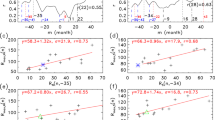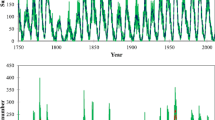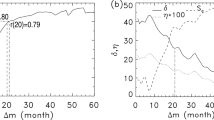Abstract
The correlations between the parameters of Solar Cycles 12 – 24 for the smoothed monthly mean sunspot numbers of the total [\(R_{\mathrm{T}}\)], northern [\(R_{\mathrm{N}}\)], and southern [\(R_{\mathrm{S}}\)] hemispheres are compared using the newly reconstructed hemispheric sunspot numbers. The main conclusions are as follows: i) the maximum amplitude [\(R_{\mathrm{max}}\)] is inversely correlated [\(r=-0.54\)] with the rise time [\(T_{\mathrm{a}}\)] of the cycle in the southern hemisphere [SH], while in the northern hemisphere [NH], they are positively correlated [\(r=0.36\)], not satisfying the Waldmeier effect; ii) the positive correlation between \(R_{\mathrm{max}}\) and the preceding cycle minimum [\(R_{\mathrm{min}}\)] in the SH [\(r=0.51\)] is much stronger than that in the NH [\(r=0.21\)]; iii) the decay time [\(T_{\mathrm{d}}\)] is found to be strongly anti-correlated with \(T_{\mathrm{a}}\) in the NH [\(r=-0.83\)], and this correlation is weaker in the SH [\(r=-0.50\)]; iv) the negative correlation between \(R_{\mathrm{max}}\) and the cycle length [\(P=T_{\mathrm{a}}+T_{\mathrm{d}}\)] in the NH [\(r=-0.51\)] is much stronger than that in the SH [\(r=-0.18\)]; and v) the correlation in even-numbered cycles tends to be much stronger than in odd-numbered ones. These seem to imply that the solar activity in the northern hemisphere evolves partially differently from that in the southern hemisphere. These results might provide constraints on dynamo models in both hemispheres. However, the correlations depend on the timings of solar minima and maxima, which are related to the smoothing method.







Similar content being viewed by others
Data Availability
The monthly mean and smoothed monthly mean hemispheric sunspot numbers (Veronig et al., 2021) are downloaded from the Sunspot Index and Long-term Solar Observations (SILSO) website (wwwbis.sidc.be/silso/extheminum). The “13-month running mean total sunspot numbers” of the second [V2] version were also downloaded from the SILSO website (wwwbis.sidc.be/silso/DATA/SN_ms_tot_V2.0.txt), Royal Observatory of Belgium, Brussels.
References
Berdyugina, S.V., Usoskin, I.G.: 2003, Active longitudes in sunspot activity: century scale persistence. Astron. Astrophys. 405, 1121. DOI.
Bracewell, R.N.: 1986, Simulating the sunspot cycle. Nature 323, 516. DOI.
Cameron, R., Schüssler, M.: 2007, Solar cycle prediction using precursors and flux transport models. Astrophys. J. 659, 801. DOI.
Cameron, R., Schüssler, M.: 2008, A robust correlation between growth rate and amplitude of solar cycles: consequences for prediction methods. Astrophys. J. 685, 1291. DOI.
Chowdhury, P., Kilcik, A., Yurchyshyn, V., Obridko, V.N., Rozelot, J.P.: 2019, Analysis of the hemispheric sunspot number time series for the Solar Cycles 18 to 24. Solar Phys. 294, 142. DOI.
Clette, F., Lefèvre, L.: 2016, The new sunspot number: assembling all corrections. Solar Phys. 291, 2629. DOI.
Clette, F., Cliver, E., Lefèvre, L., Svalgaard, L., Vaquero, J., Leibacher, J.: 2016, Preface to topical issue: recalibration of the sunspot number. Solar Phys. 291, 2479. DOI.
Deng, L.H., **ang, Y.Y., Qu, Z.N., An, J.M.: 2016, Systematic regularity of hemispheric sunspot areas over the past 140 years. Astron. J. 151, 70. DOI.
Dicke, R.H.: 1988, The phase variations of the solar cycle. Solar Phys. 115, 171. DOI.
Dikpati, M., de Toma, G., Gilman, P.A.: 2006, Predicting the strength of solar cycle 24 using a flux-transport dynamo-based tool. Geophys. Res. Lett. 33, L05102. DOI.
Du, Z.L.: 2006, A prediction of the onset of solar cycle 24. Astron. Astrophys. 457, 309. DOI.
Du, Z.L.: 2020, Predicting the amplitude of Solar Cycle 25 using the value 39 months before the solar minimum. Solar Phys. 295, 147. DOI.
Du, Z.L., Du, S.Y.: 2006, The relationship between the amplitude and descending time of a solar activity cycle. Solar Phys. 238, 431. DOI.
Du, Z.L., Wang, H.N.: 2010, Does a low solar cycle minimum hint at a weak upcoming cycle. Res. Astron. Astrophys. 10, 950. DOI.
Du, Z.L., Wang, H.N.: 2012, Predicting the solar maximum with the rising rate. Sci. China Ser. G, Phys. Mech. Astron. 55, 365. DOI.
Du, Z.L., Wang, H.N., He, X.T.: 2006, The relation between the amplitude and the period of solar cycles. Chin. J. Astron. Astrophys. 6, 489. DOI.
Gnevyshev, M.N., Ohl, A.I.: 1948, On the 22-year cycle of solar activity. Astron. Zh. 25, 18.
Hale, G.E.: 1924, Sun-spots as magnets and the periodic reversal of their polarity. Nature 113, 105. DOI.
Han, Y.B., Yin, Z.Q.: 2019, A decline phase modeling for the prediction of solar cycle 25. Solar Phys. 294, 107. DOI.
Hathaway, D.H.: 2010, The solar cycle. Living Rev. Solar Phys. 7, 1. DOI.
Hathaway, D.H.: 2015, The solar cycle. Living Rev. Solar Phys. 12, 4. DOI.
Hathaway, D.H., Wilson, R.M., Reichmann, E.J.: 1994, The shape of the sunspot cycle. Solar Phys. 151, 177. DOI.
Hathaway, D.H., Wilson, R.M., Reichmann, E.J.: 1999, A synthesis of solar cycle prediction techniques. J. Geophys. Res. 104, 22375. DOI.
Hathaway, D.H., Wilson, R.M., Reichmann, E.J.: 2002, Group sunspot numbers: sunspot cycle characteristics. Solar Phys. 211, 357. DOI.
Javaraiah, J.: 2016, North-south asymmetry in small and large sunspot group activity and violation of even-odd solar cycle rule. Astrophys. Space Sci. 361, 208. DOI.
Kakad, B., Kakad, A.: 2021, Forecasting peak smooth sunspot number of solar cycle 25: a method based on even-odd pair of solar cycle. Planet. Space Sci. 209, 105359. DOI.
Kane, R.P.: 2007, A preliminary estimate of the size of the coming solar cycle 24, based on Ohl’s precursor method. Solar Phys. 243, 205. DOI.
Knaack, R., Stenflo, J.O., Berdyugina, S.V.: 2005, Evolution and rotation of large-scale photospheric magnetic fields of the Sun during cycles 21 – 23. Periodicities, north-south asymmetries and r-mode signatures. Astron. Astrophys. 438, 1067. DOI.
Lantos, P.: 2000, Prediction of the maximum amplitude of solar cycles using the ascending inflexion point. Solar Phys. 196, 221. DOI.
Maunder, E.W.: 1904, Note on the distribution of sun-spots in heliographic latitude, 1874 – 1902. Mon. Not. Roy. Astron. Soc. 64, 747. DOI.
Newton, H.W., Milsom, A.S.: 1955, Note on the observed differences in spottedness of the Sun’s northern and southern hemispheres. Mon. Not. Roy. Astron. Soc. 115, 398. DOI.
Pesnell, W.D.: 2008, Predictions of solar cycle 24. Solar Phys. 252, 209. DOI.
Petrovay, K.: 2020, Solar cycle prediction. Living Rev. Solar Phys. 17, 2. DOI.
Podladchikova, T., Van der Linden, R., Veronig, A.M.: 2017, Sunspot number second differences as a precursor of the following 11-year sunspot cycle. Astrophys. J. 850, 81. DOI.
Ramesh, K.B., Lakshmi, N.B.: 2012, The amplitude of sunspot minimum as a favorable precursor for the prediction of the amplitude of the next solar maximum and the limit of the Waldmeier effect. Solar Phys. 276, 395. DOI.
Roy, S., Prasad, A., Ghosh, K., Panja, S.C., Patra, S.N.: 2020, Investigation of the hemispheric asymmetry in solar flare index during solar cycle 21 – 24 from the Kandilli Observatory. Solar Phys. 295, 100. DOI.
Solanki, S.K., Krivova, N.A., Schussler, M., Fligge, M.: 2002, Search for a relationship between solar cycle amplitude and length. Astron. Astrophys. 396, 1029. DOI.
Spoerer, F.W.G.: 1889, Von den Sonnenflecken des Jahres 1888 und von der Verschiedenheit der nördlichen und südlichen Halbkugel der Sonne seit 1883. Astron. Nachr. 121, 105. DOI.
Takalo, J.: 2020, Comparison of latitude distribution and evolution of even and odd sunspot cycles. Solar Phys. 295, 49. DOI.
Takalo, J., Mursula, K.: 2018, Principal component analysis of sunspot cycle shape. Astron. Astrophys. 620, A100. DOI.
Temmer, M., Veronig, A., Hanslmeier, A.: 2002, Hemispheric sunspot numbers Rn and Rs: catalogue and N–S asymmetry analysis. Astron. Astrophys. 390, 707. DOI.
Temmer, M., Veronig, A., Hanslmeier, A., Otruba, W., Messerotti, M.: 2001, Statistical analysis of solar H\(\alpha \) flares. Astron. Astrophys. 375, 1049. DOI.
Usoskin, I.G., Mursula, K.: 2003, Long-term solar cycle evolution: review of recent developments. Solar Phys. 218, 319. DOI.
Veronig, A.M., Jain, S., Podladchikova, T., Pötzi, W., Clette, F.: 2021, Hemispheric sunspot numbers 1874 – 2020. Astron. Astrophys. 652, A56. DOI.
Waldmeier, M.: 1939, Über die Struktur der Sonnenflecken. Astron. Mitt. Zür. 14, 439. ADS.
Waldmeier, M.: 1971, The asymmetry of solar activity in the years 1959 – 1969. Solar Phys. 20, 332. DOI.
Wilson, R.M.: 1993, A prediction for the onset of cycle 23. J. Geophys. Res. 98, 1333. DOI.
Yoshida, A.: 2014, Difference between even- and odd-numbered cycles in the predictability of solar activity and prediction of the amplitude of cycle 25. Ann. Geophys. 32, 1035. DOI.
Yoshida, A., Yamagishi, H.: 2010, Predicting amplitude of solar cycle 24 based on a new precursor method. Ann. Geophys. 28, 417. DOI.
Acknowledgments
We are grateful to the anonymous reviewer for valuable suggestions that greatly improved this manuscript.
Funding
This work was supported by National Key R&D Program of China under grant 2021YFA1600504 and the National Science Foundation of China (NSFC) under grants 11873060 and 11973058.
Author information
Authors and Affiliations
Contributions
The data analysis and the manuscript were completed by DZL.
Corresponding author
Ethics declarations
Disclosure of Potential Conflicts of Interest
The author declares that he has no conflicts of interest.
Additional information
Publisher’s Note
Springer Nature remains neutral with regard to jurisdictional claims in published maps and institutional affiliations.
Rights and permissions
About this article
Cite this article
Du, Z. Comparing the Correlations Between Solar Cycle Parameters in the Northern and Southern Hemispheres. Sol Phys 297, 70 (2022). https://doi.org/10.1007/s11207-022-02005-5
Received:
Accepted:
Published:
DOI: https://doi.org/10.1007/s11207-022-02005-5




